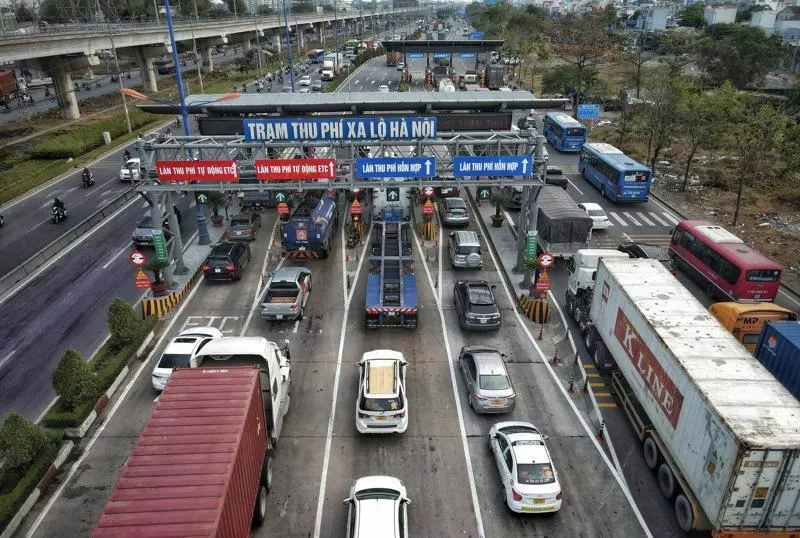
These projects are experiencing prolonged financial struggles, unable to generate sufficient revenue to cover their debts and meet interest payments to banks. Conversely, financial institutions find themselves in a predicament as the bad debt associated with these projects is substantial and likely to escalate in the near future. There was a time when banks eagerly extended loans to BOT projects due to their perceived low risk.
Challenges Persist
The challenges associated with BOT projects are exemplified by the Ho Chi Minh City Infrastructure Investment Joint Stock Company (CII), which is grappling with a significant loan interest burden. In the first nine months of 2023, CII faces financial costs amounting to VND 1,170.2 billion, with interest expenses comprising VND 920 billion. Consequently, CII is saddled with an average monthly interest payment exceeding VND 100 billion or more than VND 3 billion per day. In response to these difficulties, CII has outlined a plan to restructure its capital through the issuance of nearly VND 7,000 billion in long-term bonds during a recent extraordinary shareholders' meeting. Mr. Lê Quốc Bình, the General Director of CII, has acknowledged that the company's third-quarter and 2023 business results are unlikely to meet initial projections, emphasizing the challenging business environment.
In recent years, the majority of BOT traffic projects have struggled with insufficient revenue, failing to cover operational costs. The challenges have intensified post the Covid-19 pandemic, impacting the viability of BOT enterprises. Among the 54 BOT projects overseen by the Ministry of Transport, only seven were projected to surpass revenue expectations by 2022, with 43 projects achieving revenue levels between 30-100%, and four projects falling below the 30% threshold. To address the financial distress faced by eight BOT projects with prolonged losses, the Ministry of Transport is proposing a budget allocation of over VND 10,300 billion from the state to rescue them. The State Bank has previously indicated that the outstanding credit balance for these projects amounts to VND 15,875 billion, primarily comprising bad debts or debts restructured by credit institutions.
Consequences of Rising Bad Debt
The woes faced by BOT (build-operate-transfer) enterprises are significantly impacting banks, tracing back to the period between 2011 and 2015 when financial institutions heavily invested capital into the BOT traffic sector. Ministry of Transport statistics reveal that, during this period, the State budget, Government bonds, and preferential loans could only fulfill approximately 37% of the financial requirements for BOT and BT (build-transfer) projects. To bridge the funding gap, the Ministry of Transport advocated for socialization of investment, encouraging private investment to meet the capital needs. In 2016, data indicated that banks provided a total of VND 171,520 billion in loans, constituting over 87% of the capital for projects operated and constructed between 2011 and 2015. This underscored the heavy reliance of BOT projects on bank loans.
The increasing exposure of banks to the BOT sector prompted intervention from the State Bank. In July 2015, the State Bank issued Directive No. 05, emphasizing the need for enhanced risk control in credit activities related to BOT and BT traffic projects. The directive responded to the growing trend among commercial banks to intensify capital investment in these projects. In 2016, Directive No. 04 reiterated the importance of risk control for large customer groups and credit in the BOT and BT sectors. Consequently, BOT and BT were categorized as high-risk lending areas within the banking industry.
Since 2016, BOT traffic projects have encountered numerous challenges linked to policy issues. Issues such as investors with insufficient capital adopting a risky "fighting the enemy with nothing" investment approach and challenges during the construction process have led to projects deviating from financial plans, falling short of revenue expectations, and struggling with debt repayment. Many projects lack the revenue necessary to meet loan obligations, placing the burden squarely on banks. According to State Bank Governor Nguyễn Thị Hồng, as of September 30, 2023, 22 credit institutions have extended credit to BOT and BT traffic projects, accumulating a total outstanding debt of VND 92,319 billion. Of note, bad debt constitutes 3.83%, with debt group 2 (proximate to debt group 3 - bad debt) representing 26.52% of the total bad debt.
Diversifying Capital Sources
A recent inquiry from a National Assembly delegate urged the State Bank of Vietnam to devise solutions addressing challenges and attracting diverse sources of credit capital for forthcoming investments in transport infrastructure projects. The Governor of the State Bank emphasized the necessity of securing capital for transportation infrastructure projects, which demand substantial amounts over extended periods. However, the credit institution system primarily relies on short-term mobilized capital, posing limitations on large-volume and long-term lending due to safety ratio considerations in its operations. The Governor pointed to the US banking sector's experience, highlighting the risks and consequences associated with mobilizing short-term capital for medium and long-term loans. Consequently, policies for capital mobilization should encompass a broader spectrum of financial resources, both domestic and foreign.
Experts underscore the persistent demand for projects under the Public-Private Partnership (PPP) model, including build-operate-transfer (BOT) and build-transfer (BT) forms. Addressing this demand requires a multifaceted approach. First, there is a need for the evaluation and planning of more standardized projects, coupled with contingency plans to mitigate risks if they arise. Second, there is an imperative to broaden the channels for capital mobilization. Drawing on international experience in implementing the PPP model, four primary sources of capital emerge: equity capital (15-20%), bank loan capital (40-50%), capital raised through bonds and corporate bonds (20-25%), and capital from international financial institutions (including Official Development Assistance - ODA - if available) and investment funds (10-15%). This diversification is crucial to ensure the stability and sustainability of financing for transport infrastructure projects in Vietnam.




















